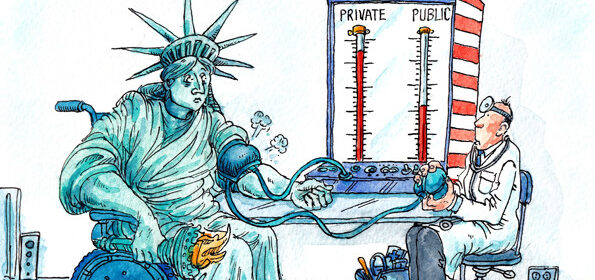Privatize versus Nationalize: Comparing American and Taiwanese Healthcare

ANAGHAH SANIKAPALLY –
As we all know, in the United States healthcare is primarily funded through a privatized insurance system. In fact, around 50% of Americans obtain coverage through their employers as of 2019, or purchase it individually. While government programs like Medicare and Medicaid exist, they provide comparatively mediocre care to only specific parts of the nation’s population, predominantly elderly and low-income individuals. The real issue is the multiplicity of private insurers because it has led and continues to lead to a highly and unnecessarily complex and fragmented system, with varied coverage options and significant administrative overhead. In contrast, Taiwan’s healthcare system operates under a government-run, single-payer, mandatory “National Health Insurance” (NHI) program. Established in 1995, Taiwan’s NHI enrolls nearly all citizens automatically (with the exception of those imprisoned and those who have left the country) and is funded through payroll contributions, supplemented by general taxation. This more centralized system allows for more uniform coverage and simplified administration.
An important facet to note is that the United States spends over around 18% of its GDP on healthcare, amongst the highest in the world and around double the amount spent by many other “first-world nations,” yet it consistently ranks low in many key health markers. The issue at hand is that administrative expenses consume a large portion of said spending: insurers, healthcare providers, and patients navigating billing codes, claims processes, and coverage disputes. Out of pocket costs such as co-pays, deductibles, and premiums create significant financial burdens for the many Americans, predominantly the middle and lower-middle classes. Taiwan, on the other hand, spends less than 7% of its GDP on healthcare, with administrative costs kept below 2% due to this efficient single-payer framework. This means that patients benefit from low medical fees and minimal out-of-pocket expenses, making healthcare both affordable and accessible for nearly the entire population.
Access to healthcare in the United States is highly dependent on insurance status; this is especially concerning as approximately 8% of Americans remain uninsured and many more are underinsured. This leads to delayed treatment, increased emergency care usage, and a higher incidence of illness from preventable conditions or death from said preventable conditions. Taiwan, however, provides nearly universal coverage, with almost 100% citizens insured through the NHI (again, not all as those imprisoned or those who have left the country are exempted). Nearly every citizen holds a health insurance card that allows seamless access to medical services across the country, ensuring that care is delivered in a timely and consistent manner regardless of income or employment status.
Despite its massive healthcare expenditures, the United States lags behind other “developed” nations in key health indicators such as life expectancy (life expectancy at birth in the United States averages around 77 years of age while Taiwan consistently averages over 80 years of age) and infant mortality (in the U.S., the infant mortality rate is nearly 6 deaths per 1000 live births, while in Taiwan it is around 4 deaths per 1000 live births). Medical debt is also a leading cause of bankruptcy, indicating the system’s financial strain on the working class. Taiwan’s health system has outcomes comparable to or better than those of many Western countries while spending dramatically less than said Western countries. The NHI emphasizes preventive care and early treatment, resulting in high public satisfaction and low levels of medical debt.
Many American patients also report irritation and difficulty dealing with high costs, coverage denials, and the bureaucracy of dealing with (and/or, for some unfortunate reason, having to convince for care) multiple insurers. In contrast, Taiwanese citizens express high levels of trust and satisfaction with the NHI; it utilizes real-time data to monitor healthcare delivery and address nearly all public health concerns, contributing to its consistent responsiveness and efficiency.
Taiwan’s nationalized health insurance system unsurprisingly outperforms the United States’ privatized model in nearly every metric. Its ability to provide comprehensive, affordable, and efficient healthcare to all citizens stands in stark contrast to the expensive and inequitable system in the U.S. The evidence strongly suggests that a nationalized system like Taiwan is comparatively better, and I believe it would offer a more viable and superior alternative to current privatized healthcare, especially to deliver better health outcomes at a fraction of the cost.
Copy Editor: Shriya Garg
Photography Source: https://econreview.studentorg.berkeley.edu/healthcare-privatize-or-nationalize/
